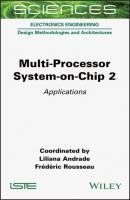Multi-Processor System-on-Chip 2. Liliana Andrade
Чтение книги онлайн.

Читать онлайн книгу Multi-Processor System-on-Chip 2 - Liliana Andrade страница 15
Название: Multi-Processor System-on-Chip 2
Автор: Liliana Andrade
Издательство: John Wiley & Sons Limited
Жанр: Зарубежная компьютерная литература
isbn: 9781119818403
isbn:
First, we indicated trends and analyzed specifications for the most advanced 5G communication standard at the time of writing this chapter and defined workloads based on these specifications. To get closer to HW requirements, we selected an example beyond 5G algorithm GFDM to implement and investigate its HW requirements for those workloads. Second, from the theory behind GFDM, we developed the processing graph and pseudo-code that does not use modulo operations. Third, the precision analysis indicated that HW should be able to handle data types of at least 32 bits (16 bit – real, 16 bit – imag) per data point for operation and that the processor accumulators should have at least [log2M] guard bits to facilitate computations without degradation. Fourth, we identified the range of kernel parameters as well as the number of calls and deadlines for the low- and high-end 5G workloads, followed by the implementation space exploration, resulting in high-throughput and low-memory access code variants of the same kernel. Finally, the kernel variants and workloads are combined to indicate required HW for corner cases. For the low-end and CA high-end vDSPs are recommended, while for higher than those and towards MIMO CA high-end workloads, more specialized (application-specific) HW accelerators or ASIPs are recommended.
We can see that giving a recommendation or direct HW requirements for SotA specifications is a multi-layered challenge that is difficult to overcome. For the overall system, other kernels can be analyzed in the same manner; however, the overarching theme is the need for variability and flexibility at each step of the analysis. Heterogeneous HW MPSoCs consisting of RISCs, vDSPs, ASIPs and dedicated (application-specific) HW accelerators can provide both flexibility and highly optimized solutions in the power consumption/chip area/chip cost sense, provided that enough care and effort has been invested into the investigation of the above-mentioned layers.
1.7. Acknowledgments
The authors would like to thank Dr. Yankin Tanurhan and the Synopsys team for their guidance, support, sponsorship and initiation of the Industry–University cooperation within the “Efficient Implementation of 5G Baseband Kernels on a Vector Processor” project.
1.8. References
3GPP (2017). Study on new radio access technology Physical layer aspects v14.2.0, TR 38.802 [Online]. Available at: https://bit.ly/2QzxmGc.
3GPP (2018a). Evolved universal terrestrial radio access (E-UTRA); Physical channels and modulation v15.3.0, TS 36.211, September 2018 [Online]. Available at: https://bit.ly/354hKjf.
3GPP (2018b). NR; Base Station (BS) radio transmission and reception v15.3.0, TS 38.104, September 2018 [Online]. Available at: https://bit.ly/30xf5wE.
3GPP (2018c). NR; Physical channels and modulation v15.0.0, TS 38.211, January 2018 [Online]. Available at: https://bit.ly/2xO4Qrt.
3GPP (2018d). Study on scenarios and requirements for next generation access technologies v15.0.0, TR 38.913 [Online]. Available at: https://bit.ly/2MCblVZ.
3GPP (2019a). Evolved universal terrestrial radio access (E-UTRA); base station (BS) radio transmission and reception v16.3.0, TS 36.104 [Online]. Available at: https://bit.ly/2xLJSto.
3GPP (2019b). Evolved universal terrestrial radio access (E-UTRA); Physical layer procedures v15.6.0, TS 36.213 [Online]. Available at: https://bit.ly/2SgRopA.
3GPP (2019c). NR; User equipment (UE) radio transmission and reception; Part 1: Range 1 standalone v15.7.0, TS 38.101-1 [Online]. Available at: https://bit.ly/2LUtz5K.
3GPP (2019d). NR; User equipment (UE) radio transmission and reception; Part 2: Range 2 standalone v15.7.0, TS 38.101-2 [Online]. Available at: https://bit.ly/2SfjQIc.
3GPP (2019e). NR; Physical channels and modulation v15.7.0, TS 38.211, September 2019 [Online]. Available at: https://bit.ly/2xO4Qrt.
3GPP (2019f). NR; Physical layer procedures for data v15.4.0, TS 38.214 [Online]. Available at: https://bit.ly/2Gg9aVb.
ARIB, ATIS, CCSA, ETSI, TSDSI, TTA, and TTC (2016). Study on new services and markets technology enablers; Stage 1 v14.2.0, TR 22.891 [Online]. Available at: https://bit.ly/39meeUM.
Damjancevic, S.A., Matus, E., Utyansky, D., van der Wolf, P., and Fettweis, G.P. (2019). Towards GFDM for handsets - Efficient and scalable implementation on a vector DSP. IEEE Vehicular Technology Conference (VTC Fall 2019), 1–7.
Farhang, A., Marchetti, N., and Doyle, L.E. (2016). Low-complexity modem design for GFDM. IEEE Transactions on Signal Processing, 64(6), 1507–1518.
Fettweis, G.P. (2012). A 5G wireless communications vision. Microwave Journal, 55, 24–36 [Online]. Available at: https://bit.ly/368uSW7.
Fettweis, G.P. (2014). The tactile Internet. IEEE Vehicular Technology Magazine, 9(1), 64–70.
Fettweis, G.P., Hassler, M., Wittig, R., Matus, E., Damjancevic, S., Haas, S., Pauls, F., Nam, S., and Grigoryan, N. (2019). A low-power scalable signal processing chip platform for 5G and beyond – Kachel. 2019 53rd Asilomar Conference on Signals, Systems, and Computers.
GFK (2019). Global smartphone sales reached $522 billion in 2018 [Online]. Available at: https://www.gfk.com/insights/press-release/global-smartphone-sales-reached-522-billion-in-2018/ [Accessed 26 December 2019].
ITU (2019a). G.722 : 7 kHz audio-coding within 64 kbit/s [Online]. Available at: https://www.itu.int/rec/T-REC-G.722/e [Accessed 4 August 2020].
ITU (2019b). G.729 : Coding of speech at 8 kbit/s using conjugate-structure algebraic-code-excited linear prediction (CS-ACELP) [Online]. Available at: https://www.itu.int/rec/T-REC-G.729 [Accessed 4 August 2020].
Matthé, M., Mendes, L., Gaspar, I., Michailow, N., Zhang, D., and Fettweis, G.P. (2016). Precoded GFDM transceiver with low complexity time domain processing. EURASIP Journal on Wireless Communications and Networking, 2016(138), 1–9. [Online]. Available at: http://dx.doi.org/10.1186/s13638-016-0633-1.
СКАЧАТЬ